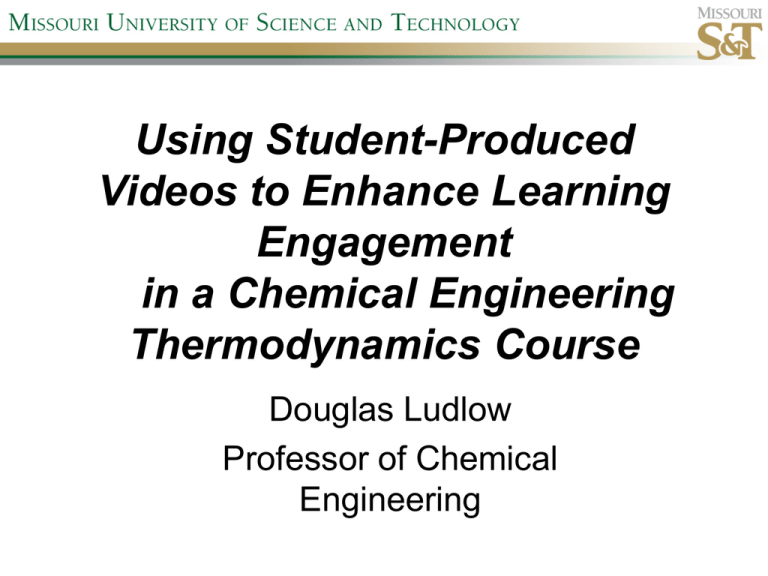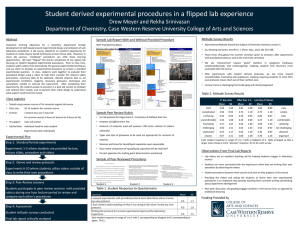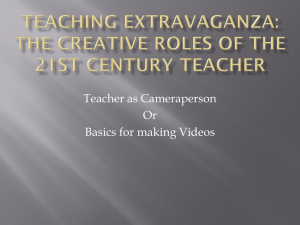Using Student-Produced Videos to Enhance Learning Engagement
advertisement

Using Student-Produced Videos to Enhance Learning Engagement in a Chemical Engineering Thermodynamics Course Douglas Ludlow Professor of Chemical Engineering Overview • • • • • Background – Genesis of idea Initial trial Assignment Student response Examples of student videos – Little of no voice over – Voice over slides – Animated – “Student Actors” Genesis of the Idea • Daughter’s Chemistry class – “Chemistry for Poets” – Created a video in place of a term paper about some chemical • Hazardous Materials Course – Term paper on hazmat scenario in Rolla area • Student would prepare paper and give presentation to class – Gave the students the option to replace PowerPoint presentation with a video about their scenario Hazmat Video Project • Elective course so students were generally interested in topic • Video assignment option given after the first of semester. Groups could opt out of video production • All groups in the class choose to prepare a video • I gave little (no) help on how to create video – Student able to figure out on their own – Created in different formats • Response from students was very positive. Thermodynamics • Required 2nd year course – ChE majors and some EnvE majors • Thermodynamics typically viewed by students as a fairly “dry” topic • Formula intensive and calculation intensive topic • How to adopt video project? Thermo Video Project - Overview • Allowed class to divide into three member groups. • Students choose topics – they were posted to minimize overlap of topics between groups • Viewed videos during last week of class (dead week) • Graded with rubric by instructor, GTA and five classmates Assignment – Create a Video: • Research, summarize, teach and give a real world example of some concept associated with: – Mathematical description of the state of material – Mathematical estimation of thermophysical properties – Applications of the first and/or second law of thermodynamics – Volumetric properties of pure fluids – Thermodynamic properties of fluids – Heat effects of processes Project Assignment Specifics • “You Tube” format – less than 10 minutes • Introduction include – Missouri S&T – Title – Student’s names Project Assignment Specifics – cont. • The video can consist of: – Pictures or videos of processing equipment – PowerPoint slides with voice over – Chalk/white board presentation – Talking head – Demonstration – etc, or some combination of all Project Assignment Specifics – cont. • Central idea – Present some thermodynamic concept or calculation related to chemical process equipment – Teach about it and demonstrate it in a format so that future students can access the video to learn more about the concept. Grading Rubric Grading Rubric – cont. Fall 2011 • Forty-two students enrolled • Fourteen videos produced • Viewed over three class periods • Different levels of quality and content • Performed anonymous survey to gauge students’ opinion of the video project Survey Results • Students asked to rate: 0-Strongly Disagree to 4-Strongly Agree • Questions about whether students enjoyed doing the video or thought it was a waste of time • Questions about whether having the videos available on-line (Blackboard) would be useful • Questions about whether they felt they would learn more without the videos Survey Results – Student Interest • “Dr. Ludlow should continue to assign the video production project” – 3.3 0.8 • “I enjoyed watching the videos prepared by my classmates” – 3.1 0.8 • “I thought watching the videos in class was a waste of valuable classroom time” – 0.95 0.96 Survey Results – Availability online • “Having had the videos available on Blackboard for review during the semester could have aided in my learning” – 2.8 1.0 • “I felt like I could learn something by viewing and reviewing the videos prepared by my classmates” – 2.7 0.9 Survey Results – Student Learning • “I feel that I would have gained more knowledge from completing a research paper project rather than doing the video project” – 1.0 1.0 • “I feel that the video project helped me to better learn some concepts of thermodynamics” – 2.9 0.9 Survey Results • “How could this video project assignment be improved?” – A few more guidelines – suggested resources – Set minimum time and also lower maximum time (9 – 10 minute videos seemed too long) – Wanted available on Blackboard (even though none had been produced yet) – Allow all class to grade each video – Numerous responses – noting that it was a fun and great assignment Survey Results • “I believe the following should NOT be part of the video project” – Allowing more than one group to cover a topic – Allowing students to not be in the video (entirely voice over of pictures) – Most of the responses indicated that nothing should be changed and they enjoyed the project Videos with little or no talk • From survey and student grading, this type of video was not received as well. • Still the video is informative • Video “Sensible&LatentHeat” Videos with Voice Over • Some groups created videos using primarily PowerPoint slides, pictures or video clips Video “CoalFiredPowerPlant” Video “CubicEOS” Animation • One group completed their video entirely as an animation. • Some student survey comments felt this was a “cop out” since the participants were not on video • Video “IdealGasProcesses” Videos with Student Actors • Some groups created entire video with live actors. • In some cases created parodies of popular TV shows. • These type of videos received more positive comments and were graded higher by the student peers. • ThermoOfPizza • DippyBird Current Status • Spring Semester – 63 students – 21 teams • Planning on using clickers to allow entire class evaluate each video • Updated suggested resource list, including Camtasia Studio available in one CLC on campus Summary • Using student generated videos to convey thermodynamic concepts – Enhanced student engagement in learning thermodynamic principles? • Definite yes – Enhanced student learning? • Haven’t quantified this yet Thank You • Acknowledge the support of CERTI at Missouri S&T for encouraging this project.






